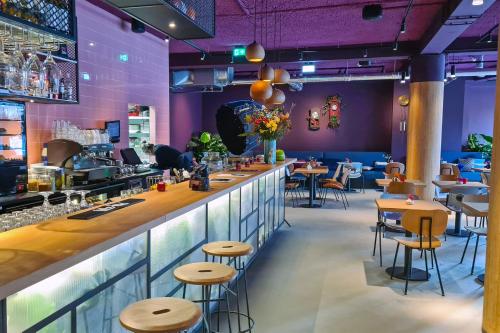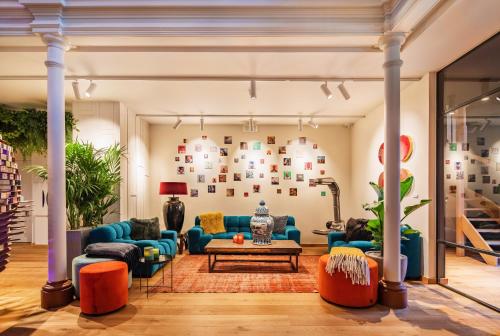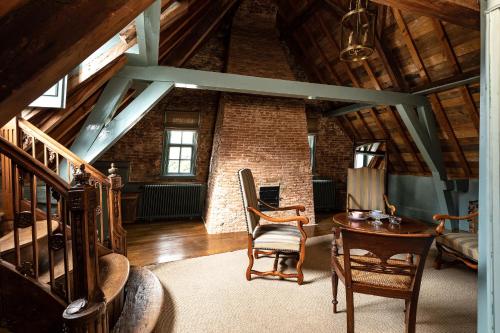Some of it seems pretty obvious by today’s design standards but in 1924 it was revolutionary. But even now, some of it is still quite remarkable.
That’s why this small house at the end of a row of terraces in the Dutch city of Utrecht has been included on the World Heritage List.
If you didn’t know about the significance of the Rietveld Schröder House you would still notice it. Walking down Laan van Minsweerd – a quiet street in eastern Utrecht – there’s a row of brown terraces one after another, almost indiscernible from the next.
Then you get to the end, just in front of an overpass, and there’s this strange small white house with yellow and red poles jutting out.
The overpass wasn’t there in 1924 when the house was constructed. Back then there were just open fields as far as the eye could see. That’s why architect Gerrit Rietveld and his client, Truus Schröder-Schräder, chose this location.
Why is the Rietveld Schröder House important?
When it was built in 1924, the Rietveld Schröder House introduced a whole new type of architecture, using space in revolutionary ways with movable parts. It’s still considered to be one of the best examples of the De Stijl movement, and was named a World Heritage Site in 2000.
What materials is the Rietveld Schröder House built with?
Unlike the brick houses around it, the main structure of the Rietveld Schröder House is made from reinforced concrete slabs and steel. The walls are made from brick and plaster, while the doors and floors are wood.
Can you visit the Rietveld Schröder House?
Yes, you can visit the Rietveld Schröder House but you can only go in on one of the official tours, which run regularly.
What Gerrit Rietveld created was a modern masterpiece, rethinking so many fundamental assumptions of how residential architecture should look.
Now, a century after it was built, it is still considered one of (if not THE) best piece of architecture from the De Stijl movement, a style of modern art that developed here in the Netherlands in the early twentieth century.
There are limited spots available each day for tours, so I would recommend booking a ticket here in advance.
Although it may not be the most famous landmark in the country, or perhaps even in Utrecht, it is a fascinating building and I really think it’s worth making the effort to visit the Rietveld Schröder House when you’re here.
History of the Rietveld Schröder House
When the idea for the house was coming together, what the client, Truus Schröder-Schräder, wanted was something that felt unconstrained by space and boundaries. A widow with three children, she liked the idea that the intersection between the indoors and the outdoors would be blurry.
She was obviously a progressive woman – in fact, she met architect Gerrit Rietveld through her work as a social worker and they became good friends.
Together they reimagined the way a house should be laid out. They threw design principles of the time out the window and challenged the orthodox.
Rietveld was a member of the De Stijl movement, and he was influenced by its principles of abstraction, simplicity, and geometric forms.
He designed the Rietveld Schröder House to reflect these principles, and he also incorporated some of his own innovative ideas into the design.
When it was built in 1924, it was recognised immediately as a masterpiece, and was featured in magazines and held up as an ideal example of the De Stijl movement (probably helping to introduce the style to new parts of the world).
Truus Schröder-Schräder lived in the house for many years and the residence was owned by the family until 1963. It was then bought by the city of Utrecht who opened it as a museum in 1975.
It’s been restored and protected ever since, so when you visit the Rietveld Schröder House today, you’re guaranteed to see it in its best condition.
It’s also one of the World Heritage Sites of the Netherlands.
The Rietveld Schröder House’s architecture
Unfortunately photography wasn’t allowed inside when I visited, so you’ll have to let me describe it for you with words.
The first thing you notice, once you go in, is that the downstairs is fairly conventional. But this is all a sham. The kitchen and bedrooms based around a central staircase were designed in such a way so they would get building approval.
But these rooms, other than the kitchen, were never intended to be used for anything in particular. They are spares. The upstairs, which is officially an attic (if city officials asked) is where they let their imaginations run free.
At first glance, it looks strange. That’s because it is essentially one open space (apart from the toilet and bathroom).
There are beds in the corners which have a direct view of the dining table and the other beds. There’s no clear sense of where the living area stops and the sleeping areas begin.
In fact, it seems like they can be one and the same.
Then the guide, who is showing me and the other tourists around the house, starts pushing hidden sliding doors, lifting decorations off the wall and covering windows with them, pulling on a rope to lift up the skylight cover, opening windows and sliding them away so they disappear, and more.
All these little secrets the house had been hiding transformed it into something else.
Bedrooms could be closed off, the shape of the living space could be changed, sunlight could flow in or darkness could fall.
The entire upstairs of the Rietveld Schroder House is malleable to suit the needs of the moment.
There are so many other little things that I could tell you about but I fear we would be here all day. The tiniest little details – things you would never normally see in houses – had been considered.
The way a ceiling is painted black so it turns an internal window into a mirror from one side; the way coloured vertical poles move between being outside to inside to break down the barriers of walls; the way one end of a cupboard door is painted a darker colour so finger marks don’t show up.
It’s a house designed from the inside out, around its inhabitants. It leaves you amazed at how one small house could have so many interesting and ingenious features.
Visiting the Rietveld Schröder House
I think it’s great that the Rietveld Schröder House is open to the public so everyone has a chance to see it (unlike the Stoclet Palace in Brussels, unfortunately).
But you do need to take a tour, and they can fill up during busy periods, so it’s worth booking in advance (details below).
The tour takes about 30 or 40 minutes. You’ll get a media player with loudspeaker (or you can bring your headset) or you can use your smartphone (QR code) to explore around the ground floor, then a guide will show you all the secrets of the house upstairs.
A few other things to note:
- Unfortunately, the century-old architecture means the Rietveld Schröder House is not accessible for wheelchairs or strollers.
- There’s a small shop with Rietveld souvenirs in the ticket office next door
- There’s a coffee bar in the former garage of the house, which is open during the opening hours of the RSH, except on Saturdays.
Where is the Rietveld Schröder House?
The Rietveld Schröder House is in eastern Utrecht close to Wilhelmina Park.
The house is located at Prins Hendriklaan 50, Utrecht, Netherlands. You can see it on a map here.
How do you get to the Rietveld Schröder House?
If you’re going to get to Rietveld Schröder House by public transport, take the number 8 bus bound for Wilhelminapark from Utrecht Central Station. Get off at De Hoogstraat and the house is just a five-minute walk from the bus stop.
Check 9292.nl for detailed public transport information.
When is the Rietveld Schröder House open?
The Rietveld Schröder House opening hours are as follows:
Tuesday – Sunday: 11:00 – 16:00
There are extended opening hours to 21:00 on Fridays from May until August.
NOTE: It is closed on Mondays
What is the Rietveld Schröder House entrance fee?
Entrance to Rietveld Schröder House, including the tour, costs:
Standard ticket: €19.00
14 – 17 years: €10.50
0 – 13 years: €3.00
NOTE: You have to purchase your ticket online and book a date and time. There’s only a limited number of tickets available each day and they sell out fast, so book in advance here.
Are there tours to the Rietveld Schröder House?
Because the only way to visit the Rietveld Schröder House is with an official tour, there aren’t any other tour companies that offer visits to the site.
However, you can book a private group tour for up to 12 people, with an expert guide about to tailor the tour to accommodate specific interests. The private tour takes about an hour and should be booked a minimum of 4 weeks in advance through the Rietveld Schröder House website.
For more information, see the official website of the Rietveld Schröder House.
A visit to Rietveld Schröder House can be combined with a stroll through Wilhelmina Park. It’s only a 5-minute walk to this beautiful city park with large trees, a central pond, and a playground.
If you’re really into architecture, combine a visit to Rietveld Schröder House with the Van Ravesteyn House a bit further up the street. Visits are only possible at the weekend as you can rent the house as a holiday home during the week.
Other interesting sights in Utrecht include the Railway Museum and the Dick Bruna House.
Looking for an easy lunch? Grab a wood-fired pizza at Bastacosi in the Jan van Scorelstraat.
THE BEST ACCOMMODATION IN UTRECHT
Utrecht has a good range of accommodation and you should be able to find something in the city centre at a reasonable price.
BACKPACKER

For a good value hostel with a great vibe, I suggest Stayokay Utrecht Centrum.
BUDGET

Utrecht is an expensive city, but you can get reasonable private rooms at the cool Bunk Hotel
BOUTIQUE

When it comes to design hotels, I love what Hotel Beijers has done with the heritage building.
LUXURY

And with the best of modern luxury, Inntel Hotels Utrecht Centre also has a fantastic breakfast.
Time Travel Turtle was a guest of Visit Utrecht but the opinions, over-written descriptions and bad jokes are his own.
It is quite handy to cover the windows like that! 😀 I wonder why they don’t built more homes like this. Maybe the expense or just not practical after all? Nice to read more by your hand on this heritage site.
I’m surprised too that there hasn’t been more inspiration from this house in modern design. The whole house would seem a bit weird to many people but you could definitely adapt quite a few of the ideas to use space better.
What an interesting sounding house! Could you imagine being a kid playing hide and seek in a house that can transform?
Without it transforming, it would be a pretty quick game of hide and seek – You’d open our eyes and see the other person! 😮 But, yeah, if you could be constantly moving the walls and stuff, it would be heaps of fun!
It was a revolutionary house in its time. The architect was member of the same ‘De Stijl’-movement as the painter Mondriaan so you could look at the house as a Mondriaan picture in 3D.
If you happen to go to Strasbourg you can visit a dancehall in the same style.
Awesome! I haven’t been to Strasbourg so I’ll definitely have to put the dancehall on the list for when I get there. I really loved the De Stijl style.
Aha! Very interesting. Never heard of this place nor the architect but now I’m really intrigued. A house that has secrets and features and the ability to change sounds pretty awesome. Like a superhero mansion or something. They just didn’t show you the bat-cave underneath it. Reminds me of the documentary “Garbage warrior” about the work of architect Michael Reynolds in which he has to constantly battle legal issues during the realisation of his ideas. Must be very frustrating. Who knows how different we would and could live if there were more people willing to try something unorthodox and less people maintaining everything red tape…!
Well, as space becomes more and more important (particularly in urban areas) perhaps people will look back to houses like these and get some ideas. I doubt it’s as hard as it was back then to do something a bit weird. You always see houses on the tv or in magazines that are just strange… but I’m not sure they’re done that way for practical reasons.
Not sure I could deal with something SO freeflowing, but I definitely like a bit more open-plan. Germany likes doors and very definite splits. Not always my thing either, it can feel claustrophobic.
There is an architect in the US who writes a series of books called the Not So Big House, about having spaces being the right size and not being too big as is the wont of much of America. I haven’t read the books in a while, but I wonder how much she was inspired by this guy.
When I think about the typical house there are so many spaces that are rarely used. Often there’s a dining room but the family will eat in front of the tv, or in the kitchen. Or there’s a guest bedroom that’s only used a couple of times a year when great aunt Beryl comes to stay. It amkes a lot of sense to be able to use those spaces how you want for most of the time and then just easily convert them into something else on the rare occasions you need them.
wow that sounds pretty cool! I wish they had let you take photographs
I wish I could have taken some photos too but apparently the inside of the house is ‘copyrighted’… whatever that means… 🙂
Wow, amazing house, it looks like you always find interesting and awesome places to share
This one was in the middle of nowhere, in some sense, but definitly worth the trip out of the centre of the (beautiful) city.